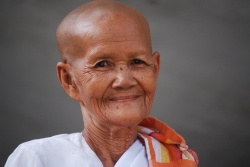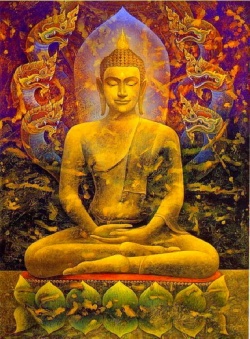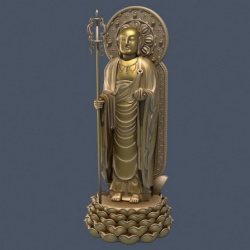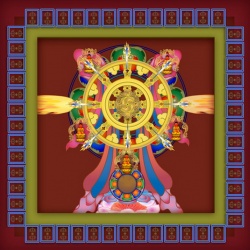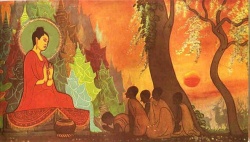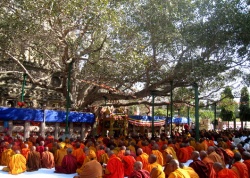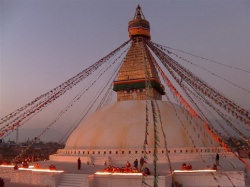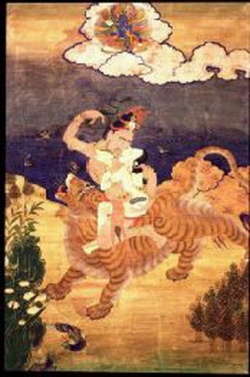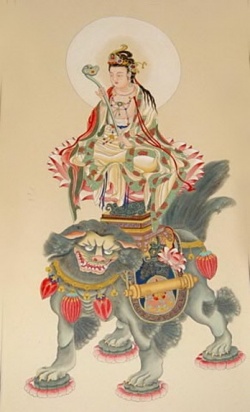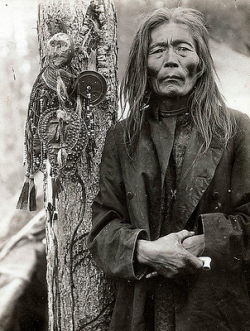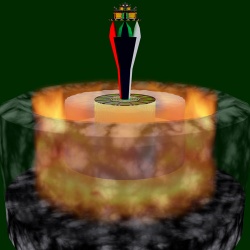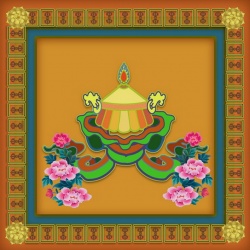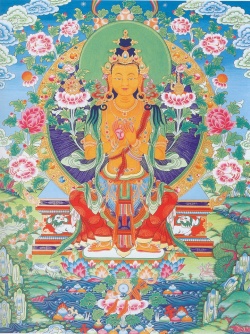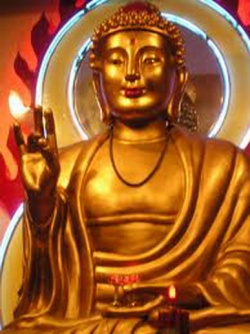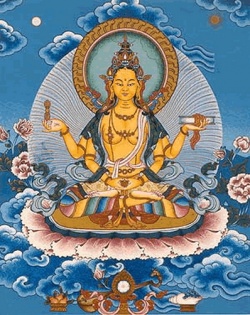The Murder of Gotama the Buddha in Doctrine
This the story of the murder of the Buddha as told in the oldest Buddhist scripture on earth dating back some 2400 years as recorded in the suttas. I shall lay forth every detail in scripture as to the murder, the motive, and the resultant downfall of the Buddha’s doctrine upon the devious demise of the Buddha. What transpires is no less than cold-blooded treachery of the highest order among the Buddhist monks themselves who sought death upon the Blessed One, and to take strong arm control of his followers.
It is the refutation by scripture alone, that the modern notion of a lineage in Buddhism, or that Kashyapa was the Buddha’s successor, is a complete lie and just the opposite is indeed the true case. With every ounce of material from sutta, there was no person named to control the Order of monks.
A heartless murder firstly of the disciples of the Buddha before the assassination of the Buddha himself were the keen plans of but a few monks whose devious ends were fulfilled to control the Sangha. What is laid forth in this collection is no less than the destruction of Kashyapa, the notions on the parinibbana of the passing of the Buddha, and the lie that anyone was named to be a successor by the Buddha. A more damningly condensed collection of scripture in refutation of modern Buddhism does not exist and hopefully this will set straight the notion that modern Zen, Mahayana, Theravada, and Vajrayana have regarding any lineage which they have deviously constructed over the past 2000 years in contradiction to the oldest Buddhist scripture we have.
Cunda
It should be pointed out for clarification that there are two Cundas in scripture. The first Cunda, who is the good fellow, is Maha-Cunda, Shariputra’s younger brother and an Arahant that is mentioned in the Theragatha, and at (A 3.355). This Cunda was under the tutelage of Ananda himself and was a personal attendant to the Buddha at different occasions.
The wicked Cunda, who murders the Buddha, is called Cunda, or Cundaka (meaning betrayal), or Cunda the kammaraputta (literally meaning “son of the great Evil One”, or “son of the wicked deed”, incorrectly called “the metal worker” in other incorrect translations or “the
blacksmith”), Cula-Cunda (disease-betrayal), also as Cunda Samanuddesa (Cunda the novice). This Cunda is the same who dwells in the small township of Pava that is most likely located in the northwest of India near the present day Punjab territory. The peoples of this area were called the Mallas. The Mallas are identified with the Malloi mentioned in the Greek accounts of Alexander the Great’s invasion of India (D.P.P.N. p. 454). This township lies within the heart of the Jains and their leader Nigantha Nataputta, who also died (was murdered) in this town of Pava, the same as the Buddha who had been poisoned there at (D 2.127). Ananda contemptuously refers to Pava as a “little filthy lawless mud hole of a town in the midst of the jungle, a small township (D 2.146).” In the account of his previous lives and that of his parents at (P.T.S. 1.101), he is stated that one time he was once a deva-god of men by the name of Dujjaya (crooked, evil, wickedness) and that his parents are Brahmins named Vanganta and Sari meaning “crookedness” and “bodily-death, pestilence” respectfully. Kashyapa speaks of him fondly on a few occasions. Little is mentioned of Cunda outside of the time at Pava at his home where he murders the Buddha. But at (Ang 5.263), the Buddha who is staying at the mangrove forest of Cunda asks him about his beliefs and Cunda responds that he believes firmly in the ascetic rituals of the Brahmins and their water purification rituals, their worship of fire, and water. It may indeed be that Kashyapa led Buddha to this mangrove dwelling of Cunda, with whom he had prearranged with to have the Blessed One murdered. There seems to be no evidence to the efficacy of Buddha staying in a town so strongly held by the Jains and the Brahmins and so small and out of the way that Ananda calls it to be a lawless little mud hole of a township. At (Dha 1.105) quite posthumously interjected in Abhidhamma commentary, it appears that Cunda arises again as a man named Cunda Sukarika who is a pig butcher near Veluvana Township. For forty-five years he was a pig butcher and goes mad and crawls around on the dirt like a pig and just before death, he sees Avici hell open up before him. When the Buddha (posthumously interjected) is told of this mad man, the Blessed One states that it is a result of his horrific wickedness that he is of such a state, and that he sees hell opening up before him.
As it thus turns out, Cunda kammaraputta (the betrayer who is the son of the Evil One) is by scripture given the title of “the son of Mara.” Little more verification than this would seem necessary to show how and why he murdered the Buddha, since the Blessed one on so many occasions had been visited by Mara who had requested that Shakyamuni pass away before attaining parinibbana. At (D 2.104-107) in the Mahaparinibbana sutta, the Buddha encounters Mara who bequests of the Buddha “Now is the time for the exalted one to pass away!” The Buddha replies that he shall not pass away until the brethren and sisters of the Order have become fully established in the Buddha’s Dhamma (which doesn’t transpire since he was murdered) and they are masters of his doctrine and it has spread far and wide. And he goes on to state “I shall not die O’ evil one until this pure faith of mine shall become successful, prosperous, wide spread and popular in full extent.” But Mara requests of him again “Now is the time for the Lord to pass away (rather prophetic), it has become all that you have wished for (false), you must now die! The time has truly come for the exalted one to die! (which fits perfectly with the fact that Mara’s son Cunda, shall murder him within three months time)!” At (D 2.106), the Buddha “deliberately and consciously rejects the remainder of his natural term of life (prognosticating the fact that he shall be cut short in his prime of life, even at 80 years old, knowing that he shall soon be murdered by some from his own Order, namely Kashyapa with Cunda).” At this relinquishing of living out a natural life, there is an earthquake and the heavens thunder (D 2.107) forth and it rains in reply to the Buddha relinquishing the continuance of his natural life, having become reconciled to the fate that he shall be murdered in three months time.
The “sukaramaddava” poison
At (D 2.127) Cunda (Cundaka) feeds the Buddha the “sukaramaddava” which some have attempted to translate as hog’s-mincemeat, cow’s drink which would be a beverage (impossible since it was a meal), a witch’s type of elixir (also absurd), others have speculated it to be a type of mushroom or fungus that is trampled by pigs (accurate), and others have thought it to be the shoots from bamboo that pigs trample. The prefix is really in no doubt, as it pertains to the “sukara”, meaning pig or of
pigs, or pig’s “x” to whatever it modifies, in this case that being the “maddava.” It is known that native peoples of the area eat a fibrous root called “sukara-kanda” and the prefix “sukara” is surely ascertained. Since we know that the consuming of this “maddava” brings about rather quick death to the person that consumes it, we know that it is something known to kill pigs as well as humans. As it happens, this “maddava” is a variant on Madda “crushing, killing, demise” or from Maddati or Maddana; both being quite equal in that they convey the notion of destruction, crushing or demise [PED p.518]. By process of elimination we know that it was a meal so that it cannot be a drink, or elixir, nor could it have actually been pig’s flesh, not because it was meat since the Buddha didn’t forbid the eating of meat as such, but that it would have been in the highest manner of bad etiquette to attempt to serve meat to the Buddha if something else was at hand. The commentary which states that this was the “succulent flesh from a pig neither too young nor too old” is inaccurate and absurd.
What was served to the Buddha was actually “pig’s demise.” It had this name because pigs can and do eat anything that doesn’t move and some things that do, and farmers had to keep this mushroom or tree fungus growth out of the pastures where their pigs grazed so they would not eat it and perish, thereby ruining a farmers good and valuable pig. Hence it was called in the vernacular “pig’s demise” or “pig’s death” as it was well known to the peoples as something to watch out for in their grazing land so that pigs would not get a hold of it and perish, since they would be bound to eat it like everything else. This mushroom or tree growth fungus/root was most likely chopped up and placed in a stew or broth when it was fed to the Buddha at his last meal. At (Ud 4 Abhi.) it states that when Cunda serves this to the Buddha he thinks, “Let the Blessed One NOT attain final Nibbana upon eating this!” But the Gods in the heavens kept the Buddha from dieing immediately after eating this so he could enter into Samadhi and attain final Nibbana.
The murderous demise of the noble disciples of Buddha
Cunda himself was a busy fellow in scripture, it turns out that he is the angel of death as it were when it comes to mysteriously being present and many high level deaths or murders and reporting that news to the Buddha before lastly, the Buddha himself falls prey to Cunda’s treachery. At (M 3.266) Shariputra and Cunda are looking after Channa who is afflicted with the same dysentery type illness of poisoning as the Buddha suffers, and later which Shariputra has. Channa says that his pains are so awful that he is wishing to knife himself. Cunda gives Channa a speech, which in no other than certain terms urges him to do so, and after they depart the room, Channa indeed does kill himself.
Little is Shariputra to know that because of his preeminence in the Order, being only second to the Buddha himself as the Blessed One proclaims him, that he shall befall the wrath of Cunda and Kashyapa’s plans to put the Order in their hands and eliminate anyone whom the Order would know to be the given successor after the murder of the Buddha. Shariputra died only two weeks before the Buddha’s other preeminent disciple Moggalana. Shariputra was murdered by poisoning from Cunda the novice (Cundaka, Cula-Cunda, Cunda the kammaraputta) who had been attending upon him at (S 5.162). He is afflicted with seemingly the same symptoms as the Buddha. Cunda quite mysteriously is the only one who attends to his sickness, being sudden and mysterious; Cunda has him cremated afterwards and brings the remains to Ananda.
Moggalana is second in line to die immediately after Shariputra. At (J 5.125), Moggalana is beaten to death by a plot of the Jains (Niganthas, who were the same who had a subplot with Kashyapa and Cunda to murder the Buddha and Shariputra, and place Kashyapa in power). It is most likely that Cunda himself in Pava plotted to have Moggalana murdered. Now that Shariputra and Moggalana are out of the way, the next step is the murder of the Buddha, for Kashyapa to take over control of the Order. Its revealing that Cunda is the attendant man at the murder of Shariputra, Channa, and murders the Buddha, and Moggalana is murdered by the Pava dwelling Jains who paid to have Moggalana beaten to death; all of this from the same lawless town the Buddha is murdered in and where Cunda himself lives.
The head of the Jains, Nigantha Nataputta, dies at (M 2.243) Pava, which is the same hometown of Cunda. Nigantha Nataputta on his deathbed (of mysterious
circumstances), realizes the futility of his teachings, and to effect his followers transference to the Buddha’s Order which he wishes them to go to, he states to half of his disciples that his teachings are one of Nihilism, and to the other half he states that his teachings are Eternalism (DA 3.906). The Order of the Jains splits up as a result of this, but of course Jainism itself survives. Some of these fanatical naked ascetics are the ones that find allegiance behind Kashyapa who himself is radical in his observance of self-mortification and Brahmanic austerities. Once again Cunda is the bringer of news on death (or rather murder) at (M 2.243), regarding Nigantha Nataputta. The heretical Kashyapa along with his new found followers who are Jainism ejects that have come under Kashyapa, are the main reason for the eminent demise of the Dhamma as primary importance, which was replaced by self-mortification and hollow austerities by Kashyapa.
Cunda and the murder of the Buddha
At (D 2.126), the Blessed One states to Ananda that it is time to travel to Pava (the lawless mud hold township, as Ananda proclaims of it). The Buddha, Ananda and a few of retinue are to stay at Cunda’s Mango Grove. Cunda, the son of the evil one, becomes aware that the Buddha is coming to stay at his Mango Grove and approaches the Buddha as requests of him “May the exalted one do me the favor of taking his meal together with the brethren (he wishes to feed all of them the “pig’s demise”, including Ananda, but the Buddha realized immediately the intentions of Cunda and he asks that that dish only be fed to him and none to his disciples including Ananda; as Cunda wishes to murder them all with the same dish) tomorrow at my home?” The Blessed One signifies that he shall by remaining silent. At (D 2.127), Cunda hence departed the Buddha immediately and during the night he prepares the poison at his residence for the murder the next day as he intends to murder them all (but only the Buddha eats of the poison). He prepares sweet rice and cakes and a large quantity of “pig’s demise.” It is obvious that he intends to murder them all at once including Ananda since the rice and cakes are meant to be side dishes to the main course of the “pig’s demise.”
Cunda announced to the Blessed one that “The hour has come O’ Lord ([for you], hidden meaning that his time has come), the meal is ready.” At (D 2.127), the Blessed One takes his seat with his brethren as Cunda is passing out the meal, but the Buddha stops him short stating “As to the pig’s demise Cunda, you may serve that to me only, but you may serve the sweet rice and cakes to the rest of my Order.” Cunda replies, “Just so Lord! (eagerly anticipating the poisoning of the Buddha)” And so Cunda served the pig’s demise (mushroom stew) to the Buddha, while the other side dishes of sweet rice and cakes were served to Ananda and the Order. Just then the Blessed One stated to Cunda that “Whatever may remain of the pig’s demise dish Cunda, that are leftover now, bury that death in a hole (such that throwing it out the window, an animal may come across it and eat it and perish as well)!” Then the Blessed One continues with an important statement “There is no entity Cunda, on earth, nor Mara in hell, nor Brahmin in heaven, not a single one among Samanas nor Brahmin in all the world systems, among gods and men, who could make proper use of this for the going forth unto the sweet destiny of Samma-Perfection other than the holy Tathagata.” This very important line “paribhuttam samma parinamam gaccheyya annatra tathagatassa (D 2.127)” has been mistranslated by Pali translators who do not understand the proper meaning of the word samma (Perfection, hypostasis, the abode after passing across parinibbana), or the sublime nuances in this sentence. What this sentence uttered after the consumption of the poison by the Buddha means, is that there is no entity anywhere, either in heaven or on earth, that could make proper use of this deadly poison save for the Tathagata (Buddha) himself. Such that only a Sammasambuddha (Samma-Perfection dwelling Buddha), who is perfectly emancipated from all false clinging to this world is wholly unaffected by the consumption of this deadly poison; not that his body can escape its deadly effects, but that his deathless essence (Attan) shall suffer no after effects from this dastardly deed so horrifically dealt out by Cunda in murdering the Buddha. Since we know the Buddha is aware that he been cornered (being betrayed by Kashyapa and Cunda), and that he has relinquished the remainder of his life and knew that he would be murdered, it is a given that we know positively that his physical body shall very soon perish from this poisoning,
but he is of such a perfectly enlightened state that even this shall have no effect on the Tathagata (who cannot perish, save for his physical body). This is the meaning of that very important sentence given by the Blessed One immediately after consummation the poison by Cunda.
Cunda did as the Buddha requested and buried the pig’s demise in a hole (so that no animals would consume it and die). At (D 2.128), “Having consumed the meal provided by Cunda, the Lord was immediately struck by a very severe sickness with bloody vomiting, dysentery, and incredible pains that racked his body, he felt as if he were at the brink of death. But the Blessed One in his strength bore the sickness by his fortitude without complaint.” He addresses Ananda stating that they should go to Kusinara. At (D 2.134), the Buddha is followed by Cundaka to the River Kakuttha. What is to be of note here is that Cunda name is now Cundaka, literally a subtle nuance, that having now poisoned the Buddha, he is now called in fruition Cundaka (meaning betrayal). Cundaka folds a robe for the Blessed one to rest on and sits down before him watching him, presumably to make sure that his death is well carried out, such that he is finally finished in this world. At (D 2.135), the Buddha addresses Ananda with “It may happen Ananda that some (of the Order) should try to stir remorse within Cunda the son of the evil one, by saying: Thou art evil Cunda! To the lower regions with thee that when the Tathagata has eating his last meal from thy own giving, such that he perished forthwith! Any kind of remorseful stirring of remorse Ananda, within that of Cunda, the son of the evil one, should be met with by stating: This is your merit Cunda, that is your well wrought deed (unto the Buddha), it shall be thy own gain, such that when the Blessed Tathagata has eaten his last from thy own giving that he perished! From the very speech of the Blessed One, Cunda, I have heard that there are two offerings of food that are of equal merit greater than any other, and what are these two? The offerings of food, from which the Tathagata has eaten, that he attains perfect enlightenment; and the offerings of food upon which the Tathagata has eaten that he passes away in which nothing whatsoever remains behind (that clings, which would be reborn). These two offerings of food are of equal profit. What has been wrought by Cunda, the son of the evil one, that shall lead
to many lives (many rebirths from karmic actions), to many births, to his own happiness, to lordship in the nether regions (a place of fame in hell), and to his increase of power (at his murderous deed). In this way Ananda, there should be no recourse to cause remorse to arise in Cunda, the son of the evil one.”
At (D 2.137), The Blessed One and his retinue (although not mentioned, Cunda probably follows) go to the Malla Sal-grove of trees in the vicinity of Kusinara. At (D 2.156), the Blessed one passes away as a result of the murderous poison given to him, the Blessed One, by Cunda. After giving some exhortations and telling Ananda that the Dhamma shall be the teacher, he passes on.
Kashyapa the heretic and fool
Now is the time to introduce the mastermind behind Cunda’s treachery, and the heretic that self righteously appoints himself the head of the Buddhist Order after the murder of the Buddha, that of Kashyapa. This single man who formerly belonged to a heretical Brahmin sect who is widely heralded by Mahayana and Zen as their forefather and “lineage holder”. There is a well known Mahayana farce where the Buddha twirls a flower and Kashyapa smiles, thereby passing some form of wordless “Dhamma heir” confirmation; since the Buddha expressly pointed out no successor to follow him save the Dhamma, not once but three times. The Theravadans themselves have falsely constructed prestige upon Kashyapa, which is undeserved. The Buddha himself thought Kashyapa to be a fool. The nuns of the Order detested his presence, and we know that Kashyapa was a horrific curse when it came due to exhort the new monks of the Order as will be shown below. Nuns left the Order as a result of his lack of insight into the Dhamma, the Buddha chides him, and Shariputra’s own nephew is credited with a verse about his heresy that is beyond damming. The fact remains that Kashyapa is never named an Arahant by anyone in the Nikayas, even he himself never bestows that upon his own being. As your shall read on, the only person in the suttas of Buddhism that praises Kashyapa, is Kashyapa himself. Indeed he is the very example and earliest point of great schism in the Order while the Buddha was still alive, and even greater schism by far after his murder. Kashyapa lies as to what the Buddha proclaims of him, he lies of himself as a Dhamma heir in spite of the Buddha’s
final requests including the retention of the unimportant monastic rules, which the Buddha says may be discarded.
This very puthujjana monk goes about, heralding that he has never slept on a bed in 120 years, wearing filthy robes, living deep in the woods, and is a champion to the downtrodden. As a point within the history of Buddhism, it is not an heir that Kashyapa must be remembered as since he himself bequest that in opposition to the Buddha’s request; rather as the first destroyer of the Dhamma, must be his epitaph be by which all Buddhists should remember him. Hater of women, praiser of self-mortification, disobeyer of the Buddha’s requests, hated by nuns and monks alike, a former heretic ascetic of radical austerity Brahmanism, the man who plotted the Buddha’s murder and succeeded by Cunda’s hand, unable to give discourse on the Dhamma, ridiculer of Ananda who inherited the robe and bowl of the Buddha and not Kashyapa himself; this is the Kashyapa of scripture. The Kashyapa portrayed in Zen and Mahayana is not the same man so foolish and despised in the oldest Buddhist scripture on earth, that being the Nikayas. This very same who had the Buddha’s most beloved murdered, that of Shariputra and Moggalana, that same whom is called fool by many and begs of the destitute in filthy rags contrary to the Buddha’s bequests. This very same Kashyapa by Cunda’s hand who almost succeeds in murdering Ananda himself along with the Buddha. By a will of power and false claims of succession, which are lies, this is the man that stole the Buddhist Sangha. Here is the false Dhamma heir who murdered the Buddha and his most beloved and put in place of the Dhamma, acetic austerities and self-mortification to impress the townsfolk.
Here we find what Kashyapa heralds, not the Dhamma, but fame for his mortifications. At (MN 1.214), the venerable Shariputra asks Kashyapa what kind of monk would illuminate the holy Sal-wood tree. Kashyapa replies “Reverend Shariputra, a monk that is a forest dweller and who praises forest dwelling, he wears filthy rag robes himself and praises the wearing of filthy rag robes, he has few wishes and praises few wishes, he is aloof and praises aloofness, he is possessed of moral habits and praises the success in morality.” After Shariputra and Moggalana were murdered within two weeks of each other (and the Buddha not long after), the
Blessed One states at (S 5.164) “O’ monks, this assembly is now to me as if completely an empty hollow now that Shariputra and Moggalana have attained final Nibbana; this assembly was not an empty hollow to me before, and I had no concern for whatever quarter Shariputra and Moggalana dwelled in.”
Here we have the Buddha himself declaring Kashyapa to be a fool, rather damning for the one who claims to be the Buddha’s successor. (Udana 4) And the Lord saw Kashyapa wondering in Rajagaha in search of alms food in the direction of the streets of the very poor, the streets of those suffering great hardships, the streets of the downtrodden weavers. Then the Lord seeing this matter (of Kashyapa begging from the destitute and downtrodden), gave rise at that time to this Udana: “There is a fool who feasts off the ignorant (commoners), that tries to establish himself in the Noble Heart; and there is one in whom the asavas (defilements) have been destroyed, with blemish gone, that one do I call the true Brahmin!”
In the Buddhavatamsaka Sutra (the Gandavyuha chapter) it is states that great disciples such as Kashyapa “were not capable of perpetuating the continuance of Buddha’s teachings.” This is a rather damning point within scripture itself, which recognizes that Kashyapa can be no heir to anything, much less the Order.
Who is most beloved among the remaining disciples as the Buddha lay dieing; it is obviously that of Ananda, faithful preserver of the holy Dhamma. At (D 2.133), as the Buddha lie dieing, a merchant said to his man “Go hence and fetch for me the two finest golden robes in fine cloth, finished and ready to wear”; and the man agreed and did so. Then Pukkusa the merchant offered both robes to the Blessed One saying: “Here Lord, are two fine sets of robes of fine gold cloth. May the Blessed Lord graciously accept them!” The Buddha replied, “Well then Pukkusa, clothe me in one set and Ananda in the other.” Then Pukkusa did so. This acknowledges that of his disciples, since the Dhamma was to be the teacher after his passing, Ananda is the defacto chosen one who shall be the master teacher of the Dhamma (as is fitting since no other came close to Ananda in knowing all the doctrine of Buddha) after he is gone. And among all of this, Kashyapa himself was still in Pava after Buddha being
poisoned by Cunda, and there remained, only coming much later after the Buddha had already died from the murder.
There is obviously no one that shall inherit the Order after the passing of the Blessed One, since the Buddha did not lead an Order of monks, he led a group of Ariyasavakas who enjoyed the companionship of those who were warriors of the cause to penetrate deeply the light and behold the principle of the Buddha’s doctrine. At (Vinaya 2.188), the Buddha says to Devadatta who requests that he relinquish the Order to him “Not even to the great Shariputra nor to Moggalana would I hand over the Order, much less to you O’ vile evil one, who are to be vomited like such spittle!”
At (D 2.162), Kashyapa was traveling down the road from Pava (where the Buddha was poisoned) to Kusinara with a very large company of about 500 monks (Jain converts who joined behind Kashyapa as their leader because of his extreme adherence to asceticism). And wondering off the road Kashyapa sat under a tree when a certain Ajivika wondered along the road towards Pava, and he had a coral tree flower (heavenly) he had picked up in Kusinara. Kashyapa saw this man and said to him “Sir, do you know our teacher?” He replied that he did. “The ascetic Gotama died a week ago. I picked this coral tree flower there.” Some said simply that “all compounded things must pass” and what is there to worry of this natural order of things. Among Kashyapas own monks was Subhaddha who said “ Enough of this rubbish friends! Do not weep over this insignificant matter. We are now well rid of that ascetic (Buddha)! We were (saying we not himself, Kashyapa and his group) always annoyed by his harping on about “It is good that you do this. It is good that you do that! Bahh! Now we can do as we so wish, no longer do we have to follow after him anymore and we don’t have to do what we don’t want to do!” There is no doubt in the telling that for Kashyapa to make no statement on Subhadda’s heresy is rather foretelling of the groups beliefs and joy at the demise of the Buddha. It is also telling that Subhaddha says “we” and not “I”, these are the new Order of the Sangha that immediately corrupted it. At (DN 2.164), oddly enough the Buddha’s funeral fire will not light it is said until Kashyapa arrives. When he does so, he and his
500 followers circumambulate the Buddhas corpse, his body bursts into flames without being lit. This has strong implications that Kashyapa and his retinue were directly responsible for his murder and that his faithful monks cannot ignite his body, but when Kashyapa arrives, the Buddha’s body bursts into flames of itself, surely acknowledging Kashyapa as the scoundrel who betrayed him.
At (S 2.202), the Blessed One said to Kashyapa “You are old and feeble now Kashyapa, and those worn out filthy hempen rag clothes of yours must be a terrible bother for you (imagine a well known disciple of the Buddha wearing the most filthy, smelly rags imaginable as he begs for food from door to door, looking half insane. This type of self-mortification Brahmanism is rejected outright by the Buddha). Therefore you must wear new robes offered by householders Kashyapa, accept meals given on invitation (to dinner), and dwell close to me (in monasteries sometimes, or at houses. Kashyapa in his non-Buddhist self-mortification dwells in the woods like an insane hermit in spite of the Buddha’s own wishes).” Kashyapa rebukes the Buddha’s request by stating “For a long time I have been a hermit of the woods and have spoken in praise of dwelling in the woods. I have been an alms food beggar and have spoken in praise of eating alms food from begging. I have been a triple robe user and have spoken in favor of using the triple robe…I have been a hermit from society and have spoken in praise of being a hermit from society.” The Buddha replies, “Consider of what benefit (ultimately) Kashyapa have you long been a hermit forest dweller? Kashyapa counters “ Considering two benefits venerable sir. For myself I see a pleasant dwelling in this very life (refutes the doctrine of the Buddha), and I have concern for later generations thinking, ‘may those of later generations follow MY example! (This is a heresy as far as the Buddha expounds many times as it regards those with personal concerns of their fame over the penetration into the Dhamma. Kashyapa makes a horrific error in this statement). Kashyapa goes on to say that he has always been in favor of being a hermit, begging alms (often from the poor downtrodden), and wearing filthy rags. The Buddha seems to make a rather obvious exhaustive statement, since he cannot change Kashyapas heretical mind to
follow empty austerities. Buddha “Therefore Kashyapa wear filthy rags, beg for alms food, and dwell as a hermit in the woods as you please.”
There are several locations in scripture where Kashyapa is shown to be a very inferior teacher. The three exhortations where the Blessed One requests of Kashyapa to exhort the monks give a clear example of this among others. At (S 2.204), Kashyapa addresses the Buddha after being requested to give a talk on the Dhamma (backpedaling from the responsibility and from the lack of ability to exhort the Dhamma) by saying “Venerable Sir, the Bhikkhus are difficult to admonish now, and they have many qualities which makes them difficult to admonish by me. They are impatient and do not accept instruction respectfully from me.” He blames it (as he very frequently does in every occurrence in scripture) on one of Ananda’s own students and another who have been bickering as to who can teach better, longer and more (Ananda and Kashyapa; saying that Kashyapa by implication is a rather inferior teacher). In the second request by the Buddha for Kashyapa to give a Dhamma instruction to the monks, he refuses (S 2.206) saying that the monks are lazy, unwise, angry, and once again that they do not heed his teachings. At the third request by the Buddha at (S 2.208), Kashyapa for the third times states the monks are lax and do not listen to him, and are impatient to heed him. Kashyapa goes on to state that the monks of today do not heed being hermit dwellers, the wearing of filthy rags, and the begging for alms food. The Buddha seems fed up with Kashyapa and states shortly after in (S 2.210) “If Kashyapa, those leading the holy life have been ruined by the ruination of those (Brahmanic-like ascetics) who lead the holy life; those leading the holy life have be corrupted by the corruption of those (like Kashyapa) who lead the holy life, it is just such that it can be said to be so.”
The Buddha himself never names Kashyapa as an Arahant, not even Kashyapa himself does that great honor bestow upon himself, even after the Blessed One’s demise. At (Samyutta Nikaya 2.211-214), Kashyapa lauds himself quite richly to Ananda, which falsely runs contrary to the Buddha’s own rebukes upon Kashyapa of his ignorances.
At (S 2.223), Shariputra asks Kashyapa about the qualities and existence of the Tathagata after death. The Theravadans have dismissed this as Shariputra questioning Kashyapa in the presence of other novice monks, but the scripture itself indicates that they were alone. It is only another drop in the pool proving that the very learned disciples of Buddha, namely Shariputra and Moggalana, not to mention the Buddha himself, knew that Kashyapa was a Brahmanical self-mortification fool of the highest order with little or no penetration into the Dhamma and he was in fact not an Ariyasavaka as such but a puthujjana commoner in the Order of bliss-dwelling light seekers of Samma-Perfection.
At the Theragatha verses (1051-1090), Kashyapa is credited with many verses showing his heretical fanaticism to austerities and self-mortification activities such as “With his hand (an almsgiver to Kashyapa) all leprous and diseased, he offered me a morsel of food; and as he placed the morsel in my bowl, one of his fingers breaks off and falls in my bowl. I sat down at the base of the wall and ate the morsels (finger and all) he had given me. I felt no disgust at all.” At (Theragatha 1058) Kashyapa lies again with a heretical statement by saying “(I) The Buddha’s heir, are awake and meditative.” At (Theragatha 1087) Kashyapa also states insanely “ As far as the Buddha fields extend, excepting the great sage (Buddha) himself, I am the foremost in ascetic virtues. One who is equal to me cannot be found!” One could surely imagine this chest pounding shortly after the murderous demise of the Buddha by Kashyapa’s scheme.
Quite a humorous and accurate a description is given of Kashyapa at (Theragatha 1168-1171), where Moggalana enters the town of Rajagaha for alms and encounters a nephew of Shariputra himself who beheld Kashyapa with great disgust and repugnance as if “he had seen the goddess of wickedness herself (referring to Kashyapa in the pinnacle of negativity)”. Here are the verses that Shariputra’s nephew gave about Kashyapa: The seer who appears empty and silent, but is dead to the world; whose dwelling is that of a hermit, aloof from the world a hermit. The self-appointed heir to the Buddha, the wake and chief of all (sarcastically), greeted with honor only by the great Brahmins. Behold him! Empty and silent, but is dead to the world. This sage who dwells
as a hermit, aloof from the world as a hermit. The self- appointed heir to the Buddha, the wake and chief of all. Alas Brahmins give greetings to that fool Kashyapa! He who is a hundred generations removed can trace decent (making very vile reference to those foolish Brahmins who are concerned with their racial purity, which the Buddha himself detested and taught against) back to all Brahmin ancestors. Oh! Himself is he a graduate and Veda well learned (Kashyapa used to be part of a heretical Brahmin sect, and hence knew the Brahmin texts). Again and again among mankind is he reborn (saying he’s a fool that cannot escape rebirth). Though he is a teacher of the Vedas three; any past master would honor him for that (which is unimportant). To pay homage to the likes of him would not be worth a blade of straw (very serious insult saying that Kashyapa is a fool’s fool and paying homage to him is worthless)!
Kashyapa the woman hater
Everything that we know of Kashyapa is that he detests women, and nothing more so than women that have been admitted into the Order, and even then above all of that is Ananda who made it all come to fruition by bequeathing of the Buddha that women be allowed to join the Order. At (S 2.215 [after the death of the Buddha)), Ananda approaches Kashyapa and asks, “Dear friend, let us go to the nuns quarters (for a talk on the Dhamma).” Kashyapa is annoyed to attend to any of the nuns. Kashyapa proves himself time and time again that he despises the nuns and the Buddha’s acceptance at the pleading of Ananda to accept women into the order. Kashyapa says to Ananda “You go Ananda, you are the one busy with your many duties [sarcastically].” Ananda pleads three times with Kashyapa before he finally folds to the requests which Kashyapa finds so detestable of attending to the nuns, much less acknowledging their existence within Buddhism. They set off to the nuns quarters and the nuns paid homage to them and Kashyapa instructs, attempts to inspire, and exhorts (to no avail, obviously a horrific teacher on the Dhamma) to the nuns then rises from his seat and departs. But before he leaves (S 2.216) a certain nun by the name of Thullatissa, who is very upset and angry at Kashyapa, expressed her anger saying “How can Kashyapa even think of speaking on the Dhamma in the presence of the
Grand Master Ananda, the most honorable Sage unequaled? For Kashyapa to even think rashly that he can speak on the Dhamma in the presence of the Grand Sage Master Ananda, this is laughable just as if a needle peddler (Kashyapa) were to think he could sell a needle to a needle maker (Ananda)!” Kashyapa hearing this from the great nun Thullatissa says to Ananda “Ananda, how is it my friend (more sarcasm), that I am the needle peddler and you are the needle maker; or is it really that I am the needle maker and it is YOU who are the needle peddler!? (Great example of Kashyapas hereticism with Ananda and an obvious example that he is devoid of the power to inspire those whom he gives instruction to).” Ananda tries to calm Kashyapas rage (showing he is no Arahant by a long stretch) by saying that this nun is rash and foolish. Kashyapa’s anger however is boiling over and he is fuming at his lack to teach properly and receives great chiding by the nuns (surely all the nuns were equally upset at Kashyapa).
Now that Kashyapas fuming anger has boiled over, he says to Ananda “Hold it right there Ananda! Don’t let the Order have grounds to investigate you further!” This serious threat from Kashyapa is quite surprising and indicative that Kashyapa is not even a teacher on the Dhamma much less an Arahant as such. What follows is a horrific diatribe where Kashyapa inflates his importance as being equal to that of the Buddha as he speaks very insanely and harshly to the nuns and to Ananda. “What do you think Ananda, was it YOU that the Blessed One brought forward in the presence of the Order saying (goes on all the way though [S 2.218], a very long time, where Kashyapa says that the Buddha states that he is the one who enters various jhanas and so does Kashyapa. This, in and of itself, is not indicative of the Buddha praising Kashyapa at a much earlier time, which most likely did not happened. This reference is to [S 2.211-214], which is highly spurious and appears to have been inserted by Kashyapa himself). It is quite odd that the only praises of value that Kashyapa makes are ones that he himself has created, since the Buddha himself does not declare Kashyapa to be one of his star pupils, but rather Shariputra, Moggalana and Ananda are his prized students as the Buddha himself states many times over. After the very long diatribe where Kashyapa inflates
himself to Ananda and his being equal to that of the Buddha, he finally says something even more insane, proving that he is not a teacher much less an Arahant of the Buddhist Order: “Friend, one might just as well think that a bull elephant (very large) seven or seven and a half cubits high could be concealed by a palm frond as to think that MY six direct knowledges could be concealed!” This is a very laughable statement, which is very revealing about Kashyapas ineptitude in the Dhamma. After this it states that the nun Thullatissa left the Order of the nuns (S 2.217), which shows that she was disgusted that the self-appointed head of the Order could be such a reprehensible man who lacks penetration and is such a corrosive wretch who would dare threaten Ananda and puff himself up so falsely. Of these many points in scripture which show Kashyapa to be such a heretic and destroyer of the Order, one could only imagine what was not recorded in Sutta which showed a hundred-fold just how horrific Kashyapa really was and how his will to power to have the Buddha done away with and take control of the Order makes Kashyapa the first great destroyer of the doctrine.
At (S 2.218), Ananda is wandering about spreading the Dhamma to those with ears to hear with a large retinue of monks. Of the large number of new monks who were young, 30 of them left the Order for no stated reason, most likely they were too young and their hormones were raging and monkhood was not right for them yet. Ananda approaches and greets Kashyapa whence Kashyapa immediately sets in to threaten and chide Ananda once again. Kashyapa states “Why Ananda are you wandering about with these young monks who are unguarded (no proof to this) in their senses, immoderate in eating, and not devoted to penetrating the matter (baseless statement)? One would think you, Ananda, were going around as a corn crop trampler (great insult of the period, most assuredly equal to something like ‘unworthy scum’), one would presume you were going about trampling on good families (another bold insult). Your gathering is breaking apart Ananda (schism in the Sangha now present where Kashyapa’s precept strict authoritarian followers verses Ananda’s Dhamma followers), your young foolish followers are slipping away! But this young fool (before me, said of Ananda himself)
does not know what is his own measure (another bold insult)!” Ananda is quite shocked at this and states, “Grey hairs are growing out of my head Kashyapa. Surely cant we (him and his Order of those who hold true to the Dhamma of the Buddha and not the strict rule observances of Kashyapa and his clan of Dhamma destroyers) escape being called young fools by Kashyapa?” At (S 2.219), Kashyapa insults Ananda and his ‘old-school’ again by saying, “Alas Ananda, it is just because you wander around with these young fools (not young at all, old) who are unguarded in their senses (unsubstantiated), but alas this young fool (said of Ananda again) does not know his own measure!”
Another nun who had overheard this grievous insult upon Ananda, Thullananda states “Kashyapa has cast dispersion upon the Great Master Ananda, the Supreme Sage, by calling him a young fool! How can Kashyapa, who was formerly a heretic of another sect, even think to disparage the Grand Master Ananda, the Supreme Sage, by calling him a young fool?!” Kashyapa hearing Thullananda then said to Ananda “ Surely Ananda this nun Thullananda made that statement foolishly, without consideration (of the facts in his view). For since I have shaved my hair and beard and put on the saffron robes and went forth into homeless life, I do not recall (sarcastically) ever having acknowledged any other teacher except the Blessed One (saying he does not recognize Ananda as such), the Arahant the Perfectly Enlightened One (as my teacher he is saying, thus stating that Ananda is no one to him in the light of the now deceased Lord). After this Kashyapa (S 2.220) relates how he met the Blessed One and immediately knew that he was to be his teacher. The Blessed One sat down on the seat (upon Kashyapa’s robe) and said “Your outer robe of patches is soft Kashyapa.” Then Kashyapa offers his robe to the Buddha whence the Buddha asks (he asks, important point) Kashyapa “Then will you wear my worn out hempen rag robe Kashyapa?” Kashyapa concedes this and hence they trade robes. This is a purely reciprocal act between the two, not a deep meaning that Kashyapa is somehow his future successor.
They had just met and swapped robes as a sign of kinship in following the Blessed One’s Dhamma. Many peoples have incorrectly seen this act as a concession of
transmission when this is not the case. Shariputra, Moggalana and Ananda are named over and over as the most accomplished of the Buddha’s disciples, not Kashyapa, and there is nothing that is to be read into the trading of robes as one of the Buddha’s earliest followers as such. There is much sectarian commentary that hinges the Buddha’s succession unto Kashyapa because of the swapping of robes, but this is incorrect and is contrary to the fact that the Buddha said specifically there is no heir to the Order, but rather the Dhamma will be the teacher after his passing at (D 2.154). At (SA 2.133), it states clearly that after the Buddha’s death, Ananda had in his possession the robe and bowl of the Blessed One, not Kashyapa. The following is where Kashyapa makes a bold lie by calling himself the appointed heir to the Dhamma (by the Buddha). At (S 2.221-222), “If friend, one could speak from the point of Samma-Perfection, he could say of anyone: ‘He is the son of the Blessed One, born of his heart, born of his mouth (word), born of the Dhamma, created by the Dhamma, and heir (heresy) to the Dhamma, a receiver of his worn out rag robes (falsely equating heretically, that trading robes long ago conferred upon him the heir status of head of the Order)’ it is of ME that one could say this!” After this bold lie placing himself as head of the Order against the last requests of the Buddha that there shall be no heir, but only the Dhamma; Kashyapa again goes on a very long diatribe speaking on his self invented abilities at how he can enter jhanic practices and perform various god-like powers of mind. Then again he repeats, “Friend, one might just as well think that a bull elephant (very large) seven or seven and a half cubits high could be concealed by a palm frond as to think that MY six direct knowledges could be concealed!” After this horrific speech, the nun Thullananda is so angry with Kashyapa that she leaves the Order of nuns, being completely disgusted with Kashyapa’s heresy.
At (S 2.224), Kashyapa asks of the Buddha how it is that when there were fewer rules, there were more monks well established, and how now there are more rules but fewer monks are established in the way. The Buddha makes quite a timely and prophetic statement against Kashyapa who is a horrific stickler to Brahmanic-like adherence to unimportant rules which are not directly
conducive to penetration. The Buddha states, “When beings are deteriorating (Kashyapa and his rule importance) and the true Dhamma is disappearing, there are more training rules but fewer true monks who have penetrated it. But, Kashyapa, the true Dhamma does not disappear so long as a counterfeit sham Dhamma (Kashyapa’s rule following) has not arisen in the world. Then the true Dhamma will disappear. It is the senseless (Kashyapa) people right here that cause the true Dhamma to disappear.” This same question is asked by a different monk at (MN 1.444), but a completely different reply is given, showing that the answer is adjusted specifically to the disciple who in this case is Kashyapa. Specifically it is Kashyapa who is the “deteriorating” one and the one who shall give rise to the “sham Dhamma”, which will be the overthrow of the importance of the Dhamma making it secondary to that of petty monastic ([[[Vinaya]] 2.286] where Kashyapa keeps the monastic rules in spite of the Buddha’s final bequests) rules which the Buddha himself states over and over to be of no consequence in the light of penetration into the Noble Eightfold Path and other Dhamma points.
Kashyapa’s will to power over the Order
At (Vinaya 2.284), the First Buddhist Council, Kashyapa (who appoints himself as the leader) tried to keep Ananda from participating, but many of the other monks state that only Ananda was privy to most all of the teachings of the Buddha and that it would be impossible to record the teachings without him. Kashyapa folds to this obvious fact. There is an interjection here by Kashyapa and his cohorts that Ananda had not yet become an Arahant and was unworthy (neither was Kashyapa an Arahant, more importantly) to be in the Council as Kashyapa tells it. At (Vin 2.286), Ananda states that the Buddha’s last requests included the “abandoning of the unimportant rules for the Order.” Kashyapa asks specifically which rules he said could be abolished, but Ananda states that he did not ask him which (it is obvious that the unimportant rules mean all of them and the necessity to ask which is absurd at best). Then Kashyapa in another will to monastic power states that “Your reverences, listen to ME. If we were to abolish the lesser and minor rules there would be (the lay folk and townspeople) people who would say that we are lax
after the cremation of the Blessed One. It should be in conformity that we not lay down any of rules previously laid down (now contradicting what the Buddha himself requested). Your reverences let the Order listen to ME!” In yet another will to power, the rules that were requested by the Buddha to be discarded, have become preserved by Kashyapa in order to keep up appearances with the townsfolk and what they might think if the unimportant monastic rules were to be discarded.
At (A 1.24), the Buddha proclaims Ananda his foremost disciple by five different respects: erudition, behavior, memory, resoluteness, and personal attention. There is nothing even remotely similar to this as stated for Kashyapa by the Buddha. At (Vin 2.288-289), Ananda is chided endlessly for false wrongdoings (at the request of Kashyapa) in order to cast despair on the Master Ananda. “This Ananda, is an offense of your wrong doing that you did not ask the Lord which rules were to be discarded. It is an offense that after stepping on and ripping the Lords robes, that you sewed them up. It is an offense that you let the weeping nuns cry on the Lords body and defile it as such. It is an offense that you did not bequest the Lord to stay longer in this world to teach (since he was murdered, this is of no consequence at all). It is an offense that you, Ananda, made an effort to accept the going forth of women into the Dhamma as proclaimed by the Blessed One! Confess these offenses of your wrong-doings!” Ananda is woefully cornered by Kashyapas cronies to admit offenses at these five things that are of no consequence. Herein is the beginning of the end for the Dhamma and where the Dhutavadins “rule followers” of Kashyapa’s cronies take over, placing harsh monastic rules in importance over that of penetrating the Dhamma. What is not mentioned here is that the initial bequests of Kashyapa to convene the first Buddhist council were not heeded. There were many that were upset at this council as the self-appointed Kashyapa successfully prodded that the many worthless rules of the Order be kept in place contrary to what the Buddha requested as such. This marks the end of the end, after having murdered the Buddha and his beloved before that, he has, by will of power and a murderer at his right hand, taken control of that which was never given to him, that
which he doesn’t deserve, and that which he quickly destroys.
Refutation of a lineage and Kashyapa as its puthujjana successor
What must be said last of all is that there is no lineage in Buddhism, contrary to Zen, Mahayana, and Vajrayana claims. These are all based upon a myth created long after the Buddha’s passing and run 180 degrees opposite to the oldest scripture we have where the Dhamma shall be the master after the parinibbana of the Buddha. At (S 5.163, 164, D 2.100), it is stated by the Blessed One "Therefore Ananda, have the True Self as the holy illumination, dwell within the True Self as the only refuge, with no other as the refuge; have the sweet law Dhamma as the holy illumination unto thee, let there be no other refuge than the sweet law Dhamma. At (D 2.154), the Lord Buddha said to Ananda "Ananda, it may be that you would think: The supreme teacher's doctrine has vanished from the earth (after I am gone), now we have no teacher. It must not be thought of like this Ananda! For what has been well taught and explained to you as my Dharma and to my disciples will, after my death, be your true teacher.” In addition to this the Buddha says at (D 2.156) " If the Order so wishes, they may abolish the unimportant rules (of the Order) after my passing.” Ananda stated several times after the Buddhas passing that the Blessed One named no successor to his place after he was gone.
At (D 2.138), the Lord said “Ananda, whatever monk or nun, male or female follower dwells practicing the Dhamma perfectly, and perfectly fulfills the Dhamma in due course, he or she honors the Tathagata, reveres and esteems himself and pays supreme homage. Therefore Ananda, we will dwell practicing the Dhamma perfectly and perfectly fulfill the Dhamma in due course. This must be your true teacher in training. Shortly after the parinibbana of the Buddha, Vassakara asks Ananda (B.S.I. p. 40) whether any bhikkhu had been specified by the Buddha as one who would, after his death, become the leader of the Order (as a successor) under whom everyone would seek shelter. Ananda answered that there was not. Vassakara asks the same again with the same response. When asked a third time Ananda replies that
the Blessed One named the holy Dhamma to be the guiding light after his passing.
The spiritual division of the Buddhist world was represented in the Nikayas not by that of monk and layman but by that of ariyasavaka (true Buddhist with possession of vision of the way) and the puthujjana (ignorant and unenlightened commoner, not denoting layman or monk but any common fool lacking vision of the path). It was the ariyasavaka alone who was in possession of the holy revelation of Samma-Perfection, in the sense that he had seen the impermanence of the phenomenal world, the existence of a sanctuary lying beyond that realm of impermanence and also the path leading to that sanctuary. Only the ariyasavaka is on the path to Samma-Perfection within Nirvana, to the cessation of rebirth. The puthujjana, on the other hand, lacking this vision of the ariyasavaka remains ignorant of the supreme truth. This spiritual division transcends the purely social one of monk and layman since many laymen and devas were ariyasavakas and many monks were puthujjanas. Moreover, there is no doubt that there were puthujjana monks during the Buddha's own lifetime whilst at other times during his lifetime individuals became monks only as a result of becoming savakas. The real situation may be that, although those going forth under the Buddha only did so as a result of becoming savakas, there was a tendency for these monks, with or without the Buddha's permission, to ordain others who were still at the level of the puthujjana. Thus leaving the term puthujjana for the present we find that the puthujjana is one who has not heard the Dhamma, one who is unable to discern who are ariyans (noble true Buddhists with holy revelation of vision into Perfection), one who is not guided in the Dhamma of the ariyans.
The main point of difference between the puthujjana and the savaka is therefore that the former, unlike the latter, has not comprehended or penetrated one iota of the Dhamma. Thus either because he does not get to hear the Dhamma or, if he does, because he remains unaffected thereby, the puthujjana lacks the insight that arises on hearing the Dhamma and thus fails to see things as they really are. As a result he remains a fool and opposite of the true Ariyan (M iii 219) and continues to take delight in the five strands of the sense pleasures (S iv 196, 201) that are elsewhere styled the puthujjana happiness, the unariyan happiness and the dung like happiness (M 1.454,3.236, A 3.342). Moreover, it is through this continued attachment to the sense pleasures that he remains subject to Mara and as a consequence does not pass beyond old age, decay, disease and death. He is troubled by such sights of impermanence (A i 145f), remaining ignorant of the eightfold path that leads to passing beyond these (A i 180). In short the puthujjana, unlike the ariyasavaka, is still subject to dukkha (plurality of existence) in all its forms (S Iv 206‑210; A iv 158): he is still subject to repeated rebirth, often of an unpleasant kind (A i 267; A ii 126ff), and even though he may temporarily gain a good rebirth, he continually gives rise to the skandhas (S in 152). The puthujjana, then, unlike the ariyasavaka, is no end maker to Perfection within Samma (A ii 163). Therefore, only the Ariyan warrior with vision and wisdom can be a true disciple of the Blessed One, much less could anyone who is not such an Ariyan win the fruit of supreme awake in wisdom's Perfection gained by the Buddha himself.
Conclusion
Great efforts were taken to collect every morsel of scriptural data about the murder of the Buddha and the full accurate story of the heretic Kashyapa. In so reflecting back upon what we know now from sutta, it is clear and coherent that the Buddha himself did not lead an order of monks, but had many followers that were possessed with the revelation in the path to Perfection within the cultivation of Sammasamadhi; the notion of Mahayana that this horrific man of self-mortification and pathetic religious austerities was somehow the heir to some place of importance is a laugh at the least.
Hater of women, despiser of Ananda, unable to give talks to new adapts on the Dhamma, and disobeyer of the requests of the Buddha himself, Kashyapa is the true destroyer of the message of the Buddha who himself finds Kashyapa to be a fool of the highest magnitude. He himself takes strong-arm leverage after plotting the murder of the Blessed one by Cunda. Rather than placing Kashyapa on a pedestal, which most of Mahayana has done, we should see Kashyapa for who he is, the spawn of Mara himself and revile him just in the same manner as the Christians revile Judas. We know that Cunda is indeed “the son of the evil one” who actually poisoned the Buddha, but only by request of Kashyapa, or Kashyapa and Mara through his son Cunda’s evil deeds.
The Buddha refuses to name a successor but states many times that the Dhamma shall be the guiding light by which liberation shall be effected. This is how it must be, but a few in the Order found it necessary to fill the needs of their power hungry wishes to take control. The Buddha foresees the fate he shall befall and relinquished the remainder of his life and entered fully unto Perfection, resigned to the fate that his own followers had dealt him in his violent murder. There can be no lineage for the man with deep penetration in that profound matter. The Buddha rejected any authority other than that most sweetly sublime wisdom itself; sadly many Brahmanical fanatics who were deeply entrenched in asceticism and austerities are the ones that took control after murdering the Buddha, namely that of the evil Kashyapa.
What one must do is to keenly perceive that which is conducive to illumination, and those many plethora of oriental ritualisms that convey nothing, which are not cultivation, which are counter to the Dhamma, and to reject them. There are only two teachings that must be understood in the fruition of cultivation: “There are only two things I teach; suffering, and the end of suffering.” Anything which is not conducive to wisdom’s expansion of these principles cannot be said to be the doctrine of the Buddha as such. Those who choose ritualism, sectarianism, and guru-worship are not Buddhists and cultivate their own demise in those seeds sown so long ago by the heretic Kashyapa, whose will to power and murder of the Buddha was the beginning of the end for the true doctrine of Buddhism as the Buddha himself prognosticated it.
